

Compact Muon Solenoid
LHC, CERN
| CMS-HIN-13-005 ; CERN-EP-2016-217 | ||
| Measurement of inclusive jet cross sections in pp and PbPb collisions at $ \sqrt{s_{\mathrm{NN}}} = $ 2.76 TeV | ||
| CMS Collaboration | ||
| 17 September 2016 | ||
| Phys. Rev. C 96 (2017) 015202 | ||
| Abstract: Inclusive jet spectra from pp and PbPb collisions at a nucleon-nucleon center-of-mass energy of 2.76 TeV, collected with the CMS detector at the LHC, are presented. Jets are reconstructed with three different distance parameters (R = 0.2, 0.3 and 0.4) for transverse momentum (${p_{\mathrm{T}}}$) greater than 70 GeV/$c$ and pseudorapidity $| {\eta} | < $ 2. Next-to-leading-order quantum chromodynamic calculations with non-perturbative corrections are found to over-predict jet production cross sections in pp for small distance parameters. The jet nuclear modification factors for PbPb compared to pp collisions, show a steady decrease from peripheral to central events, along with a weak dependence on the jet ${p_{\mathrm{T}}}$. They are found to be independent of the distance parameter in the measured kinematic range. | ||
| Links: e-print arXiv:1609.05383 [nucl-ex] (PDF) ; CDS record ; inSPIRE record ; HepData record ; CADI line (restricted) ; | ||
| Figures | |

png pdf |
Figure 1:
Raw subtracted ${p_{\mathrm {T}}}$ for jets reconstructed with the anti-$ {k_{\mathrm {T}}}$ algorithm and a distance parameter of $ {R} = $ 0.3, in the ranges 70 $ < \text {jet} \, {p_{\mathrm {T}}} < $ 80 GeV/$c$ (top panels) and 110 $ < \text {jet} \, {p_{\mathrm {T}}} < $ 130 GeV/$c$ (bottom panels). This quantity is found by taking the difference of the sum of PF candidates within the jet cone and raw jet ${p_{\mathrm {T}}}$. Solid symbols show data, and the histogram is from PYTHIA+HYDJET generated events. |

png pdf |
Figure 1-a:
Raw subtracted ${p_{\mathrm {T}}}$ for jets reconstructed with the anti-$ {k_{\mathrm {T}}}$ algorithm and a distance parameter of $ {R} = $ 0.3, in the range 70 $ < \text {jet} \, {p_{\mathrm {T}}} < $ 80 GeV/$c$. This quantity is found by taking the difference of the sum of PF candidates within the jet cone and raw jet ${p_{\mathrm {T}}}$. Solid symbols show data, and the histogram is from PYTHIA+HYDJET generated events. |
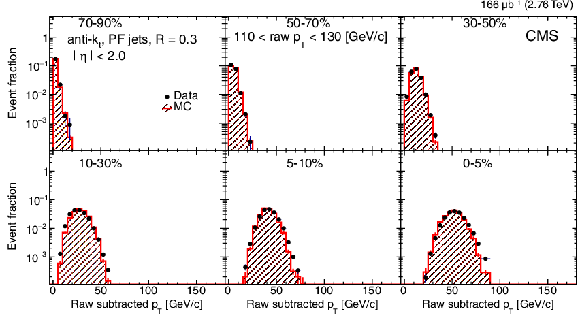
png pdf |
Figure 1-b:
Raw subtracted ${p_{\mathrm {T}}}$ for jets reconstructed with the anti-$ {k_{\mathrm {T}}}$ algorithm and a distance parameter of $ {R} = $ 0.3, in the range 110 $ < \text {jet} \, {p_{\mathrm {T}}} < $ 130 GeV/$c$. This quantity is found by taking the difference of the sum of PF candidates within the jet cone and raw jet ${p_{\mathrm {T}}}$. Solid symbols show data, and the histogram is from PYTHIA+HYDJET generated events. |
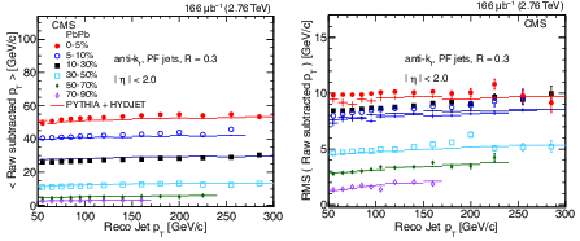
png pdf |
Figure 2:
Average raw subtracted ${p_{\mathrm {T}}}$ (left) and its RMS (right) for PF jets reconstructed with the anti-$ {k_{\mathrm {T}}}$ algorithm, with a distance parameter $ {R} = $ 0.3. Symbols represent data, and lines show PYTHIA+HYDJET simulated events. |
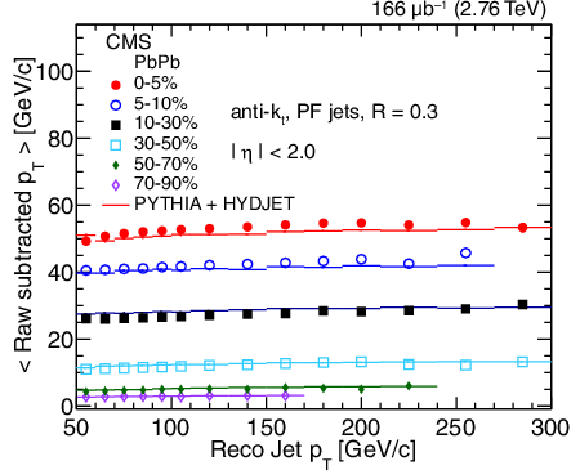
png pdf |
Figure 2-a:
Average raw subtracted ${p_{\mathrm {T}}}$ for PF jets reconstructed with the anti-$ {k_{\mathrm {T}}}$ algorithm, with a distance parameter $ {R} = $ 0.3. Symbols represent data, and lines show PYTHIA+HYDJET simulated events. |
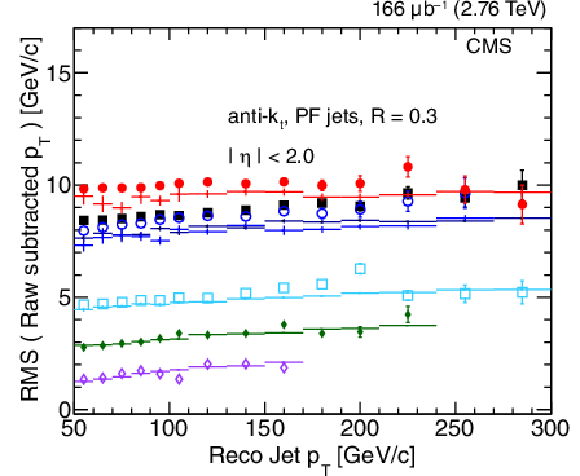
png pdf |
Figure 2-b:
RMS of the average raw subtracted ${p_{\mathrm {T}}}$ for PF jets reconstructed with the anti-$ {k_{\mathrm {T}}}$ algorithm, with a distance parameter $ {R} = $ 0.3. Symbols represent data, and lines show PYTHIA+HYDJET simulated events. |

png pdf |
Figure 3:
Misreconstructed jet fraction of the inclusive jet spectra, derived from the minimum bias sample, as a function of reconstructed jet ${p_{\mathrm {T}}}$, for various centralities and three different distance parameters (left: $ {R} = $ 0.2, center: $ {R} = $ 0.3, and right: $ {R} = $ 0.4). The correction factor is the average of the dijet selection and trigger object methods discussed in the text. |

png pdf |
Figure 4:
Comparison of the inclusive jet cross section for anti-$ {k_{\mathrm {T}}}$ jets with distance parameters of $ {R} = $ 0.2 (left), 0.3 (middle) and 0.4 (right), measured for pp collisions at 2.76 TeV (black plus markers), and NLO calculations, at the same collision energy, with NNPDF 2.1 (red star) and CT10N (blue triangle), with their respective NP corrections added. The bottom panels show the ratio of measured cross section to theory calculations. The systematic uncertainties for data are shown in the gray shaded band, while the systematic uncertainties in the NLO calculations are shown with the respective color shaded bands. |
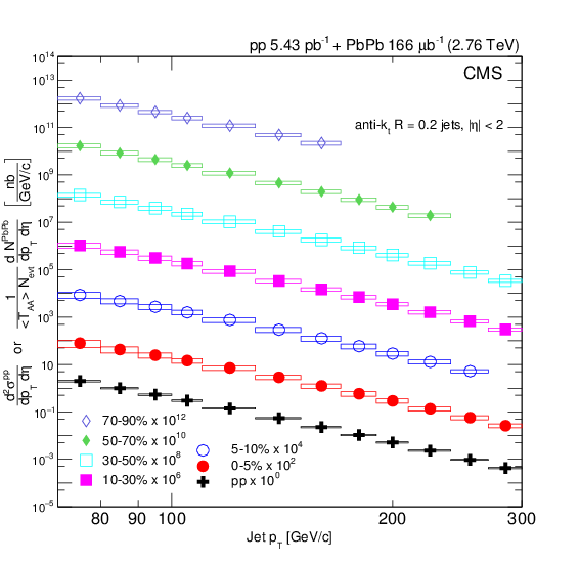
png pdf |
Figure 5:
Inclusive jet spectra for PbPb jets of distance parameter $ {R} = $ 0.2, in different centrality bins, and pp reference data. The PbPb jet spectra for different centrality classes are scaled by $ < {T_\mathrm {AA}} > $ and multiplied by a different factor for better visualization. Vertical bars represent statistical uncertainty (too small to see on this scale) with the systematical uncertainty in the colored boxes around the data points. |
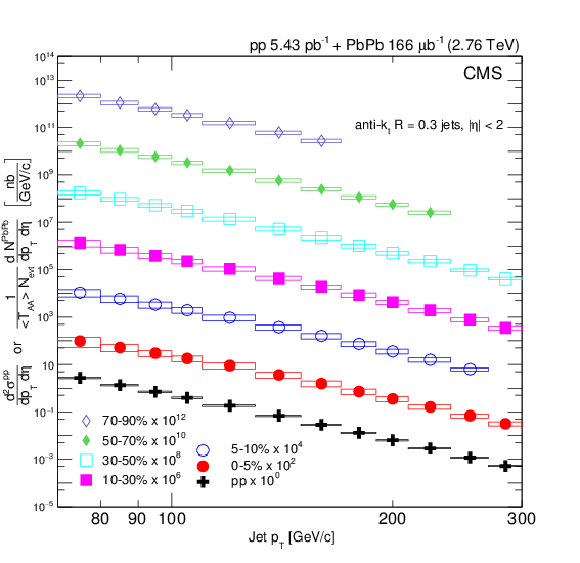
png pdf |
Figure 6:
Inclusive jet spectra for PbPb jets of distance parameter $ {R} = $ 0.3, in different centrality bins, and pp reference data. The PbPb jet spectra for different centrality classes are scaled by $ < {T_\mathrm {AA}} > $ and multiplied by a different factor for better visualization. Vertical bars represent statistical uncertainty (too small to see on this scale) with the systematical uncertainty in the colored boxes around the data points. |

png pdf |
Figure 7:
Inclusive jet spectra for PbPb jets of distance parameter $ {R} = $ 0.4, in different centrality bins, and pp reference data. The PbPb jet spectra for different centrality classes are scaled by $ < {T_\mathrm {AA}} > $ and multiplied by a different factor for better visualization. Vertical bars represent statistical uncertainty (too small to see on this scale) with the systematical uncertainty in the colored boxes around the data points. |
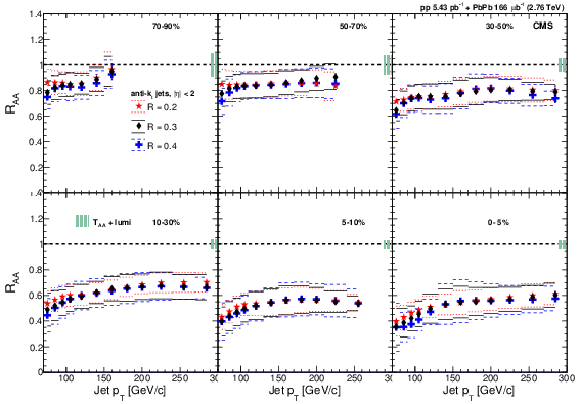
png pdf |
Figure 8:
Inclusive jet ${{R} _{\mathrm {AA}}}$ as a function of the jet ${p_{\mathrm {T}}}$, for anti-$ {k_{\mathrm {T}}}$ jets with distance parameters $ {R} = $ 0.2 (red stars), 0.3 (black diamonds), and 0.4 (blue crosses) for different centrality bins. The vertical bars (smaller than the markers) indicate the statistical uncertainty and the systematic uncertainty is represented by the bounds of the dotted, solid, and dashed horizontal lines. The uncertainty boxes at unity represent the ${T_\mathrm {AA}}$ and luminosity uncertainty. |
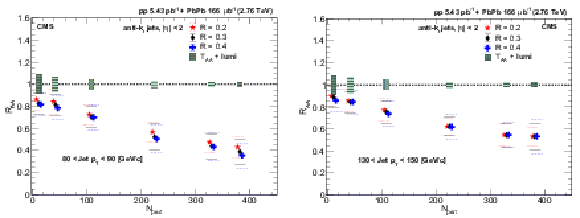
png pdf |
Figure 9:
Inclusive jet ${{R} _{\mathrm {AA}}}$ for anti-$ {k_{\mathrm {T}}}$ jets with distance parameters $ {R} = $ 0.2 (red stars), 0.3 (black diamonds), and 0.4 (blue crosses), as a function of the average $N_{\text {part}}$ for each collision centrality, for jets of 80 $ < {p_{\mathrm {T}}} < $ 90 and 130 $ < {p_{\mathrm {T}}} < $ 150 GeV/$c$, in the left and right panels respectively. Points are shifted to the left ($ {R} = $ 0.2) and right ($ {R} = $ 0.4) for clarity. The statistical uncertainty is indicated by colored vertical lines (smaller than the markers). The systematic uncertainty is represented by the bounds of the dotted, solid, and dashed horizontal lines for the corresponding distance parameters. The uncertainty boxes at unity represent the ${T_\mathrm {AA}}$ and luminosity uncertainty. |
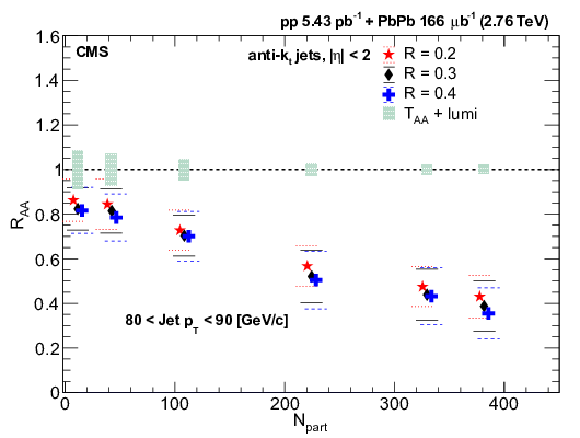
png pdf |
Figure 9-a:
Inclusive jet ${{R} _{\mathrm {AA}}}$ for anti-$ {k_{\mathrm {T}}}$ jets with distance parameters $ {R} = $ 0.2 (red stars), 0.3 (black diamonds), and 0.4 (blue crosses), as a function of the average $N_{\text {part}}$ for each collision centrality, for jets of 80 $ < {p_{\mathrm {T}}} < $ 90 GeV/$c$. Points are shifted to the left ($ {R} = $ 0.2) and right ($ {R} = $ 0.4) for clarity. The statistical uncertainty is indicated by colored vertical lines (smaller than the markers). The systematic uncertainty is represented by the bounds of the dotted, solid, and dashed horizontal lines for the corresponding distance parameters. The uncertainty boxes at unity represent the ${T_\mathrm {AA}}$ and luminosity uncertainty. |
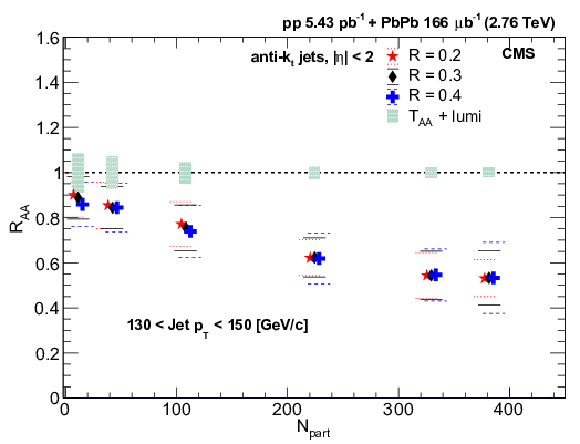
png pdf |
Figure 9-b:
Inclusive jet ${{R} _{\mathrm {AA}}}$ for anti-$ {k_{\mathrm {T}}}$ jets with distance parameters $ {R} = $ 0.2 (red stars), 0.3 (black diamonds), and 0.4 (blue crosses), as a function of the average $N_{\text {part}}$ for each collision centrality, for jets of 130 $ < {p_{\mathrm {T}}} < $ 150 GeV/$c$. Points are shifted to the left ($ {R} = $ 0.2) and right ($ {R} = $ 0.4) for clarity. The statistical uncertainty is indicated by colored vertical lines (smaller than the markers). The systematic uncertainty is represented by the bounds of the dotted, solid, and dashed horizontal lines for the corresponding distance parameters. The uncertainty boxes at unity represent the ${T_\mathrm {AA}}$ and luminosity uncertainty. |
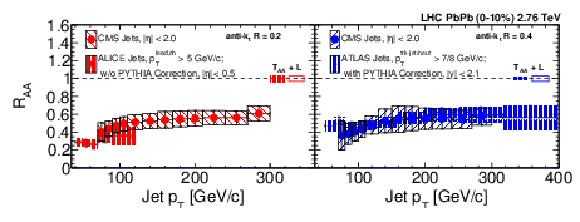
png pdf |
Figure 10:
Left Panel: Inclusive jet ${{R} _{\mathrm {AA}}}$ as a function of the jet ${p_{\mathrm {T}}}$, for anti-$ {k_{\mathrm {T}}}$ jets with distance parameter $ {R} = $ 0.2 in the 0%-10% centrality bin for CMS (closed circles) and ALICE (pluses) [27]. Right Panel: Inclusive jet ${{R} _{\mathrm {AA}}}$ as a function of the jet ${p_{\mathrm {T}}}$, for anti-$ {k_{\mathrm {T}}}$ jets with distance parameter $ {R} = $ 0.4 in the 0%-10% centrality bin for CMS (closed circles) and ATLAS (diamonds) [26]. The vertical bars indicate the statistical uncertainty. The systematic uncertainty is represented by the bounds of the boxes. The uncertainty boxes at unity represent the ${T_\mathrm {AA}}$ and luminosity uncertainty, open for CMS and shaded for ALICE and ATLAS. See text for a further discussion of differences in the analyses used by the three collaborations. |
| Tables | |
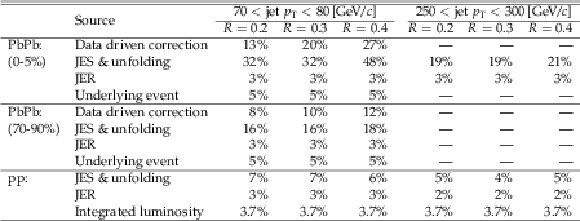
png pdf |
Table 1:
Summary of the systematic uncertainties in the PbPb jet yield for the central (0-5%), peripheral (70-90%) bins, and the pp jet cross section. Each column showcases the total systematic uncertainties for the corresponding source for the different $ {R} $ and two jet ${p_{\mathrm {T}}}$ ranges i.e. 70 $ < \text {jet} \, {p_{\mathrm {T}}} < $ 80 GeV/$c$ and 250 $ < \text {jet} \, {p_{\mathrm {T}}} < $ 300 GeV/$c$). The $ {T_\mathrm {AA}} $ uncertainties are not shown in the table. Other sources mentioned in the text that are smaller than 1% are not listed explicitly below. |
| Summary |
| The cross section of anti-$k_{\mathrm{T}}$ particle-flow jets has been measured in pp and PbPb collisions at $\sqrt{s_{\mathrm{NN}}} = $ 2.76 TeV for distance parameters ${R} = $ 0.2, 0.3, and 0.4 in $| {\eta} | < $ 2 and for jet ${p_{\mathrm{T}}} $ above 70 GeV/$c$. It is found that next-to-leading order calculations with non-perturbative corrections over predict the pp cross sections, with a smaller discrepancy for larger distance parameters. The PbPb inclusive jet nuclear modification factors show a steady decrease from peripheral to central events, with a slight rise with jet ${p_{\mathrm{T}}}$. No significant dependence of the jet nuclear modification factor on the distance parameter is found for the jets in the kinematic range measured in this analysis. |
| References | ||||
| 1 | M. Gyulassy and M. Plumer | Jet quenching in dense matter | PLB 243 (1990) 432 | |
| 2 | X.-N. Wang | Simulations of ultrarelativistic heavy ion collisions | in Proceedings, 26th International Conference on High-energy Physics (ICHEP 92), Dallas, Texas | |
| 3 | U. A. Wiedemann | Jet quenching in heavy ion collisions | in Springer Materials - The Landolt-Bornstein Database, R. Stock, ed., volume 23: Relativistic Heavy Ion Physics, Springer-Verlag | 0908.2306 |
| 4 | J. D. Bjorken | Energy loss of energetic partons in QGP: possible extinction of high $ {p_{\mathrm{T}}} $ jets in hadron-hadron collisions | FERMILAB-PUB-82-059-THY | |
| 5 | PHENIX Collaboration | Formation of dense partonic matter in relativistic nucleus nucleus collisions at RHIC: Experimental evaluation by the PHENIX collaboration | NP A 757 (2005) 184 | nucl-ex/0410003 |
| 6 | STAR Collaboration | Experimental and theoretical challenges in the search for the quark gluon plasma: The STAR collaboration's critical assessment of the evidence from RHIC collisions | NP A 757 (2005) 102 | nucl-ex/0501009 |
| 7 | PHOBOS Collaboration | The PHOBOS perspective on discoveries at RHIC | NP A 757 (2005) 28 | nucl-ex/0410022 |
| 8 | BRAHMS Collaboration | Quark gluon plasma and color glass condensate at RHIC? The perspective from the BRAHMS experiment | NP A 757 (2005) 1 | nucl-ex/0410020 |
| 9 | CMS Collaboration | Study of high-$ {p_{\mathrm{T}}} $ charged particle suppression in PbPb compared to pp collisions at $ \sqrt{s_{\mathrm{NN}}}= $ 2.76 TeV | EPJC 72 (2012) 1945 | CMS-HIN-10-005 1202.2554 |
| 10 | ALICE Collaboration | Suppression of charged particle production at large transverse momentum in central Pb--Pb collisions at $ \sqrt{s_{\mathrm{NN}}}= $ 2.76 TeV | PLB 696 (2011) 30 | 1012.1004 |
| 11 | ATLAS Collaboration | Measurement of charged-particle spectra in Pb+Pb collisions at $ \sqrt{s_{\mathrm{NN}}} = $ 2.76 TeV with the ATLAS detector at the LHC | JHEP 09 (2015) 050 | 1504.04337 |
| 12 | J. Casalderrey-Solana and C. A. Salgado | Introductory lectures on jet quenching in heavy ion collisions | Acta Phys. Polon. B 38 (2007) 3731 | 0712.3443 |
| 13 | D. d'Enterria | Jet quenching | in Springer Materials - The Landolt-Bornstein Database, R. Stock, ed., volume 23: Relativistic Heavy Ion Physics, Springer-Verlag | 0902.2011 |
| 14 | S. A. Bass et al. | Systematic comparison of jet energy-loss schemes in a realistic hydrodynamic medium | PRC 79 (2009) 024901 | 0808.0908 |
| 15 | JET Collaboration | Extracting the jet transport coefficient from jet quenching in high-energy heavy-ion collisions | PRC 90 (2014) 014909 | 1312.5003 |
| 16 | ATLAS Collaboration | Observation of a Centrality-Dependent Dijet Asymmetry in Lead-Lead Collisions at $ \sqrt{s_{\mathrm{NN}}}= $ 2.77 TeV with the ATLAS Detector at the LHC | PRL 105 (2010) 252303 | 1011.6182 |
| 17 | CMS Collaboration | Observation and studies of jet quenching in PbPb collisions at nucleon-nucleon center-of-mass energy = 2.76 TeV | PRC 84 (2011) 024906 | CMS-HIN-10-004 1102.1957 |
| 18 | CMS Collaboration | Jet momentum dependence of jet quenching in PbPb collisions at $ \sqrt{s_{\mathrm{NN}}}= $ 2.76 TeV | PLB 712 (2012) 176 | CMS-HIN-11-013 1202.5022 |
| 19 | CMS Collaboration | Modification of jet shapes in PbPb collisions at $ \sqrt{s_{\mathrm{NN}}} = $ 2.76 TeV | PLB 730 (2014) 243 | CMS-HIN-12-002 1310.0878 |
| 20 | CMS Collaboration | Measurement of jet fragmentation in PbPb and pp collisions at $ \sqrt{s_{\mathrm{NN}}}= $ 2.76 TeV | PRC 90 (2014) 024908 | CMS-HIN-12-013 1406.0932 |
| 21 | CMS Collaboration | Measurement of transverse momentum relative to dijet systems in PbPb and pp collisions at $ \sqrt{s_{\mathrm{NN}}}= $ 2.76 TeV | JHEP 01 (2016) 006 | CMS-HIN-14-010 1509.09029 |
| 22 | CMS Collaboration | Correlations between jets and charged particles in PbPb and pp collisions at $ \sqrt{s_{\mathrm{NN}}}= $ 2.76 TeV | JHEP 02 (2016) 156 | CMS-HIN-14-016 1601.00079 |
| 23 | A. Majumder | A comparative study of jet-quenching schemes | JPG 34 (2007) S377 | nucl-th/0702066 |
| 24 | J. Casalderrey-Solana, D. Pablos, and K. Tywoniuk | Two-gluon emission and interference in a thin QCD medium: insights into jet formation | JHEP 11 (2016) 174 | 1512.07561 |
| 25 | Y.-T. Chien and I. Vitev | Towards the understanding of jet shapes and cross sections in heavy ion collisions using soft-collinear effective theory | JHEP 05 (2016) 023 | 1509.07257 |
| 26 | ATLAS Collaboration | Measurements of the Nuclear Modification Factor for Jets in Pb+Pb Collisions at $ \sqrt{s_{\mathrm{NN}}}= $ 2.76 TeV with the ATLAS Detector | PRL 114 (2015) 072302 | 1411.2357 |
| 27 | ALICE Collaboration | Measurement of jet suppression in central Pb-Pb collisions at $ \sqrt{s_{\mathrm{NN}}}= $ 2.76 TeV | PLB 746 (2015) 1 | 1502.01689 |
| 28 | CMS Collaboration | Measurement of inclusive jet production and nuclear modifications in pPb collisions at $ \sqrt{s_{\mathrm{NN}}} = $ 5.02 TeV | EPJC 76 (2016) 372 | CMS-HIN-14-001 1601.02001 |
| 29 | ALICE Collaboration | Measurement of charged jet production cross sections and nuclear modification in p-Pb collisions at $ \sqrt{s_{\mathrm{NN}}} = $ 5.02 TeV | PLB 749 (2015) 68 | 1503.00681 |
| 30 | ATLAS Collaboration | Centrality and rapidity dependence of inclusive jet production in $ \sqrt{s_{\mathrm{NN}}} = $ 5.02 TeV proton-lead collisions with the ATLAS detector | PLB 748 (2015) 392 | 1412.4092 |
| 31 | M. Cacciari, G. P. Salam, and G. Soyez | FastJet user manual | EPJC 72 (2012) 1896 | 1111.6097 |
| 32 | M. L. Miller, K. Reygers, S. J. Sanders, and P. Steinberg | Glauber modeling in high energy nuclear collisions | Ann. Rev. Nucl. Part. Sci. 57 (2007) 205 | nucl-ex/0701025 |
| 33 | CMS Collaboration | The CMS experiment at the CERN LHC | JINST 3 (2008) S08004 | CMS-00-001 |
| 34 | CMS Collaboration | Performance of jet algorithms in CMS | CMS-PAS-JME-07-003 | |
| 35 | O. Kodolova, I. Vardanian, A. Nikitenko, and A. Oulianov | The performance of the jet identification and reconstruction in heavy ions collisions with CMS detector | EPJC 50 (2007) 117 | |
| 36 | T. Sjostrand, S. Mrenna, and P. Skands | PYTHIA 6.4 physics and manual | JHEP 05 (2006) 026 | hep-ph/0603175 |
| 37 | I. P. Lokhtin and A. M. Snigirev | A model of jet quenching in ultrarelativistic heavy ion collisions and high-p$ _{T} $ hadron spectra at RHIC | EPJC 45 (2006) 211 | hep-ph/0506189 |
| 38 | CMS Collaboration | Studies of jet quenching using isolated-photon+jet correlations in PbPb and pp collisions at $ \sqrt{s_{\mathrm{NN}}}= $ 2.76 TeV | PLB 718 (2013) 773 | CMS-HIN-11-010 1205.0206 |
| 39 | CMS Collaboration | Particle-flow event reconstruction in cms and performance for jets, taus, and met | CDS | |
| 40 | CMS Collaboration | Commissioning of the Particle-flow Event Reconstruction with the first LHC collisions recorded in the CMS detector | CDS | |
| 41 | CMS Collaboration | Determination of jet energy calibration and transverse momentum resolution in CMS | JINST 6 (2011) P11002 | CMS-JME-10-011 1107.4277 |
| 42 | L. Eld\'en | A weighted pseudoinverse, generalized singular values, and constrained least squares problems | BIT Numer. Math. 22 (1982) 487 | |
| 43 | G. D'Agostini | A multidimensional unfolding method based on Bayes' theorem | NIMA 362 (1995) 487 | |
| 44 | P. C. Hansen | Rank-Deficient and Discrete Ill-Posed Problems: Numerical Aspects of Linear Inversion | SIAM, Philadelphia, PA, 1998 , ISBN 978-0898714036 | |
| 45 | T. Adye | Unfolding algorithms and tests using RooUnfold | in Proceedings, PHYSTAT 2011 Workshop on Statistical Issues Related to Discovery Claims in Search Experiments and Unfolding, CERN 2011 | 1105.1160 |
| 46 | CMS Collaboration | Luminosity calibration for the 2013 proton-lead and proton-proton data taking | CMS-PAS-LUM-13-002 | CMS-PAS-LUM-13-002 |
| 47 | fastNLO Collaboration | Theory-Data Comparisons for Jet Measurements in Hadron-Induced Processes | 1109.1310 | |
| 48 | NNPDF Collaboration | Parton distributions with LHC data | NPB 867 (2013) 244 | 1207.1303 |
| 49 | J. Gao et al. | CT10 next-to-next-to-leading order global analysis of QCD | PRD 89 (2014) 033009 | 1302.6246 |
| 50 | CMS Collaboration | Measurement of the inclusive jet cross section in pp collisions at $ \sqrt{s} = $ 2.76 TeV | EPJC 76 (2016) 265 | CMS-SMP-14-017 1512.06212 |
| 51 | M. Connors, C. Nattrass, R. Reed, and S. Salur | Review of Jet Measurements in Heavy Ion Collisions | 1705.01974 | |

|
Compact Muon Solenoid LHC, CERN |

|

|

|

|

|

|